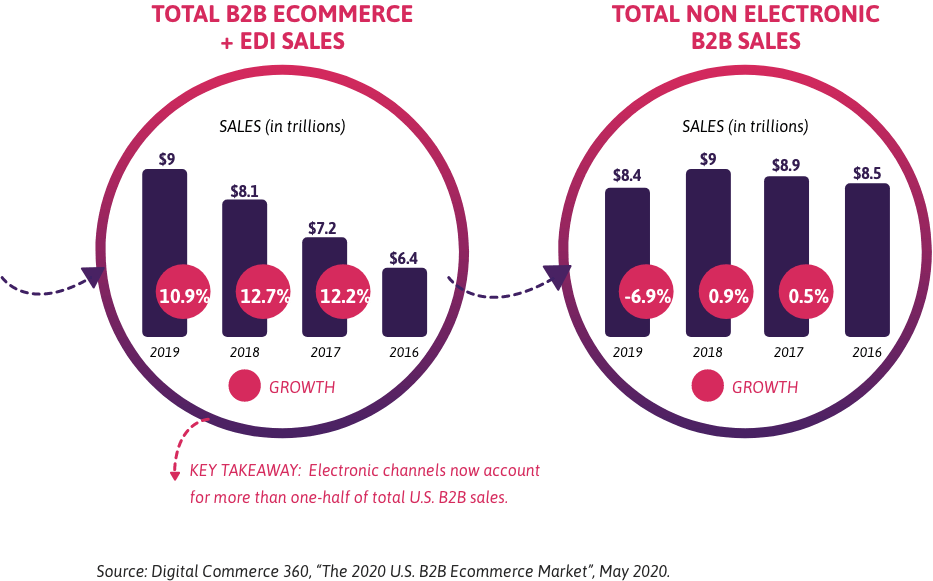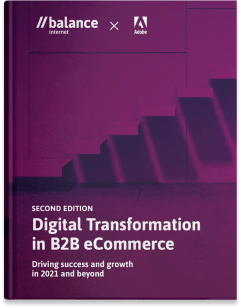Why eCommerce has never been more important in B2B selling
Latest news / 18 February 2021


Unveiling the critical role of eCommerce in B2B selling.
We are an eCommerce agency and as you’d expect, our day to day involves discussing the importance of eCommerce as a sales channel within a business’ go to market strategy. For us, we see first hand the success digital commerce can deliver. What surprises us, is the resistance of many B2B businesses to introduce or improve their eCommerce offering. We hear; eCommerce will cannibalise sales from our field team or partners, our business rules are too complex, we don’t have the resources for eCommerce, I can’t justify the business case and lack buy in from executives. This more ‘traditional’ view of B2B selling will only leave you behind as your competitors and the market moves forward. But don’t just take our word for it, here are some key industry statistics and trends from global research papers that should help spark that internal fire and get eCommerce on the priority list today!
Digital Commerce 360 published their report “The 2020 U.S. B2B Ecommerce Market” with data as of May 2020 stating, “how the business-to-business ecommerce market fared in 2019 and where it’s headed in 2020 is literally a tale of two economies.

Last year was, in fact, another growth year for B2B ecommerce. In 2019 electronic sales channels in all forms— eCommerce sites, log-in portals, marketplaces, e-procurement systems, electronic data interchange, and other online buyer/seller networks— grew 10.9% to $9.00 trillion from $8.10 trillion. In comparison, all sales by U.S. manufacturers and distributors grew year over year by just 1.75% to $17.5 trillion from $17.1 trillion.
As digital commerce continues to emerge as a mainstream and permanent sales channel for manufacturers, distributors, wholesalers and other sellers of all sizes, it’s clear that digital buyers have a growing appetite for even more eCommerce. Last year, the online sales that took place on B2B eCommerce sites, log-in portals and marketplaces increased 18.2% to $1.3 trillion from $1.1 trillion in 2018. B2B eCommerce in 2019 grew 9 times faster than the growth in all U.S. manufacturing and distributor sales.”
Further Brian Beck states within the report, “B2B eCommerce sales accelerated in 2019 in large measure because more business buyers and sellers now see digital commerce as a more efficient and effective way to research and purchase corporate goods and services, say eCommerce analysts. “Once a buyer climbs the learning curve and realises their job is easier using digital tools, they will not go back to manual processes.”
These findings portray the significant market shift that the 2020 pandemic has accelerated. And fundamentally exhibits that once buyers transition to an online buying experience they will not return to more traditional means, be it with your business or a competitor who has captured the digital needs of the customer.
eCommerce is a measurable sales channel in its own right, but further to this it is a research and selling tool that significantly influences other sales channels within a business. “Global B2B eCommerce Market 2018,” yStats, September 2018, report stated 61% of all B2B transactions start online. Independent customer research conducted via eCommerce platforms better positions a customer for conversion at point of purchase – across all channels. While a sales team is more equipped to convert customers utilising eCommerce as a product information and selling tool than without it. eCommerce shouldn’t be siloed or shyed away from, it needs to be embraced and embedded within a business for the business to truly absorb the benefits it can deliver.
451 Research’s report “Voice of the Enterprise: Customer Experience & Commerce, Digital Transformation”, December 2019, documented that 54% of B2B businesses interact with customers via an eCommerce storefront, while 33% plan to interact with customers through an eCommerce storefront in the next 2 years. Only 13% don’t have plans in the next 2 years for eCommerce. These findings demonstrate the monumental shift that is taking place now. In two years time, if 87% of the B2B market has an eCommerce storefront servicing customers and your business is yet to embark upon or embrace digital transformation, what do you think the long term outcome will be for your business? Knowing that once a buyer shifts to electronic purchasing they are unlikely to shift back to more manual processes, a business needs to assess what impact this will have on their market share and take action now.
Also from 451 Research’s report “Voice of the Enterprise: Customer Experience & Commerce, Digital Transformation”, 51% indicated that an eCommerce site or customer online portal is their ideal customer experience when making B2B transactions. It is therefore not surprising that the main driver for digital transformation (61%) is to improve customer experience.
Digital Commerce 360, “The 2020 B2B Distributor 300” details what B2B buys experience when purchasing from eCommerce sites some of the time:
- Limited product selection 71%
- Inaccurate inventory 72%
- Inability to place a quick reorder 67%
- Search that returns poor results 62%
- Inability to checkout due to errors or shopping cart forms that are non-functional 73%
- Inaccurate customer/account information hindering placing an order 58%
- Lack of transparency and/or difficulty knowing when a product will be delivered 65%
- Unsophisticated mobile offering 66%
- Lack of integration 64%
This presents a huge opportunity for B2B businesses to gain competitive advantage by overcoming these barriers to purchase. The customer experience needs to be the number one driving factor in all departments of a business, which in-turn needs to be integrated within the businesses service delivery, ecosystem and operations.
The need to focus on eCommerce and provide customers the digital buying and integrated experience they are seeking has never been greater. 2020 has upended the business world as we know it and the clock is ticking for who can reach digital maturity first.



